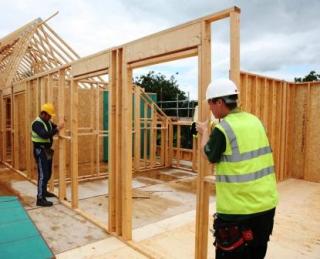This month we finally saw the publication of the results of the Allowable Solutions Consultation: Next steps to zero carbon homes. This is the Government response and summary of responses to the consultation and can be viewed here. Whilst some detail has been added regarding setting a path to Zero Carbon by 2016 (e.g. it will be led by developer choice, retrofitting solutions could be elsewhere, there will be a National Framework and there will be an exemption for smaller sites (criteria yet to be determined), the granular understanding of what an allowable solution looks like is yet to be determined, but importantly it does not rule out some kind of a system based on embodied carbon.
 Since BWF proposed this suggestion through our consultation response submitted for the Timber Industry Accord, the concept of using embodied carbon as an allowable solution has gained traction. It is supported in a recently publish guide by the Royal Institute of Chartered Surveyors and was the subject of a debate attended by BWF CEO, Iain McIlwee, and jointly hosted by the ASBP and Cullinan Studio. This event prompted some robust discussion on the work of the Embodied Carbon Task Force, who are looking at how embodied carbon could be included as an allowable solution in the zero carbon definitions. The initial report is available here and we will be working with them on this initiative. We very much welcome any input, evidence, comments or volunteers to support the work from the wider membership
Since BWF proposed this suggestion through our consultation response submitted for the Timber Industry Accord, the concept of using embodied carbon as an allowable solution has gained traction. It is supported in a recently publish guide by the Royal Institute of Chartered Surveyors and was the subject of a debate attended by BWF CEO, Iain McIlwee, and jointly hosted by the ASBP and Cullinan Studio. This event prompted some robust discussion on the work of the Embodied Carbon Task Force, who are looking at how embodied carbon could be included as an allowable solution in the zero carbon definitions. The initial report is available here and we will be working with them on this initiative. We very much welcome any input, evidence, comments or volunteers to support the work from the wider membership
The importance of embodied carbon is very much underpinned by the publication of the Performance Gap report by the Zero Carbon Hub, which highlights how far away we are from delivering zero carbon homes. Iain was at the launch of this report with the Construction Minister Stephen Williams MP. The report flags up some major shortcomings in the house building sector and if you look to the Evidence Review Report there are some pretty stark findings. For example:
100% of sites reviewed found some evidence of product substitution, though it was not always clear whether it was occurring on site, at procurement or due to the supplier. Instances included incorrect blockwork, different windows, and continuous instead of split baseplates at lintels. Of particular concern is that some sites reported that no changes would be made or that if they were, they would always be reported, and yet instances were observed on site of changes that were not reflected in the SAP assessments.
This report is something we would recommend all members read as the ramifications go way beyond the zero carbon debate and highlight specification and installation problems that undermine performance across the piece, particularly in areas like passive fire protection.
Timber has a natural advantage in providing a low carbon and low energy solution, this is a key message in our manifesto and we will be continuing to work to ensure that this is recognised by government, specifiers, clients and the wider building community.
Iain McIlwee
Chief Executive, BWF

 Since BWF proposed this suggestion through
Since BWF proposed this suggestion through